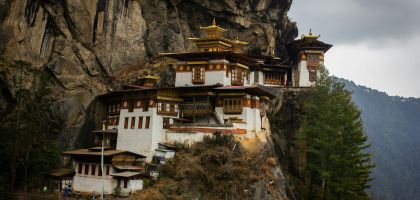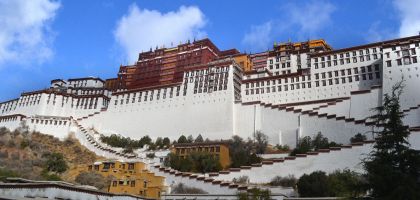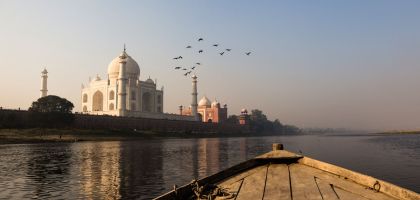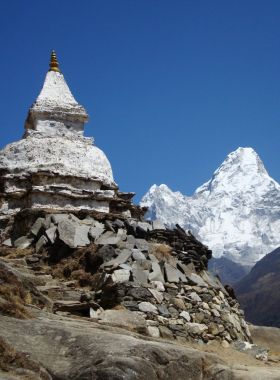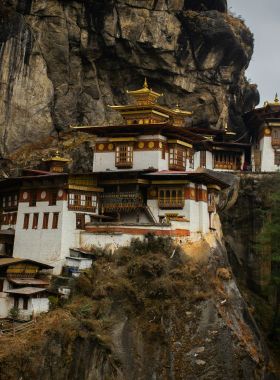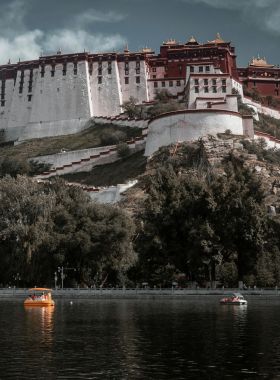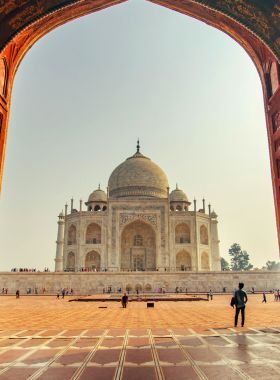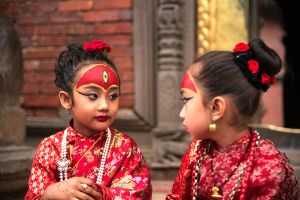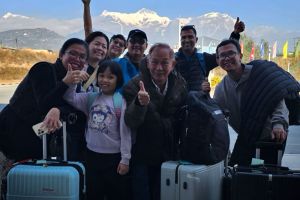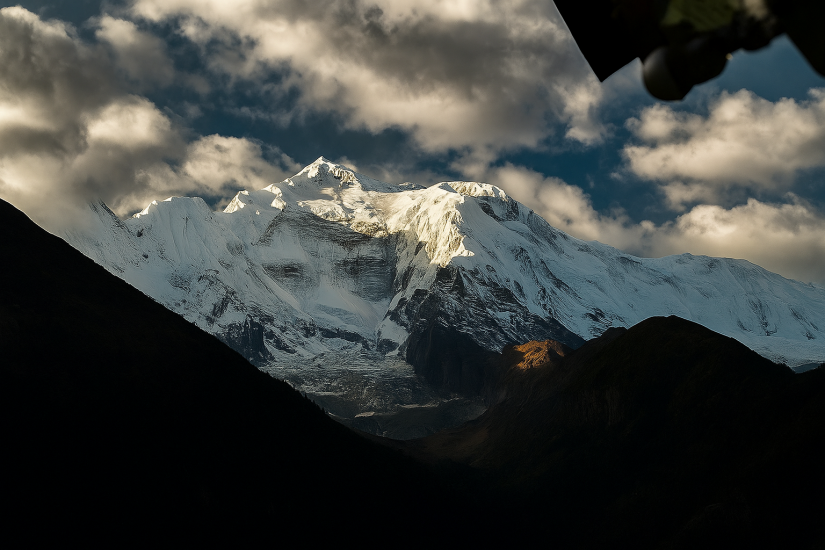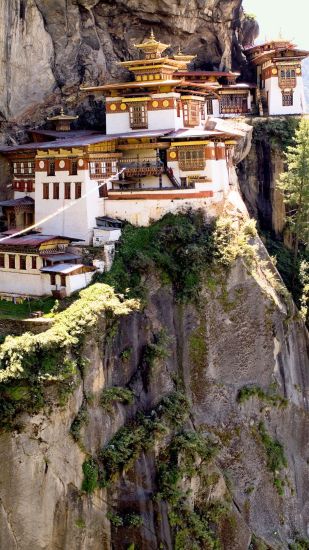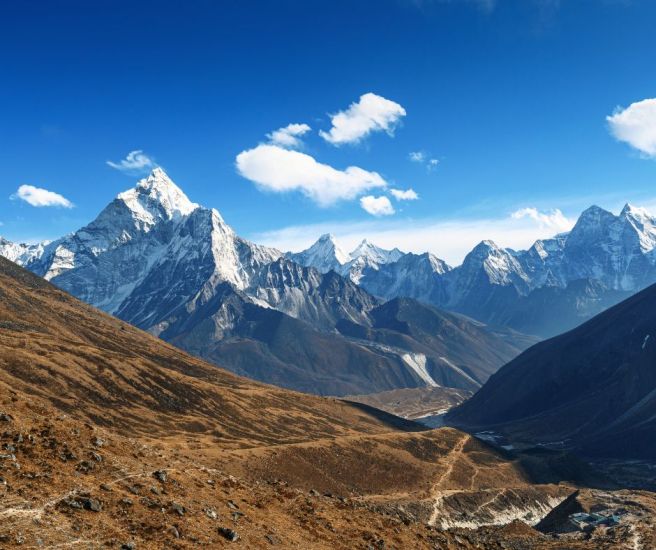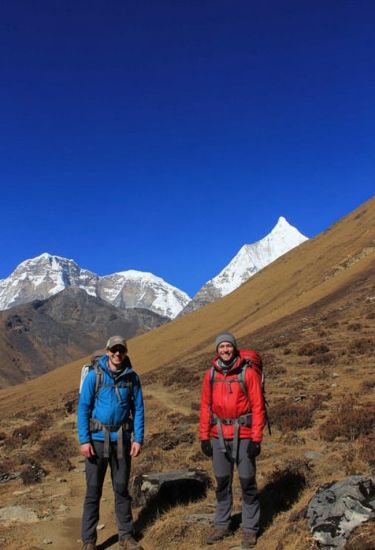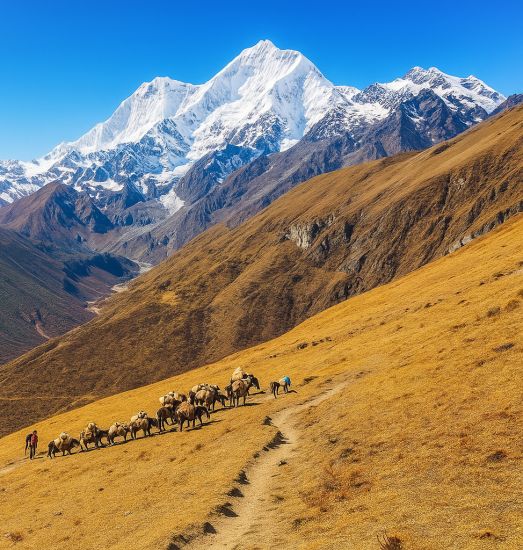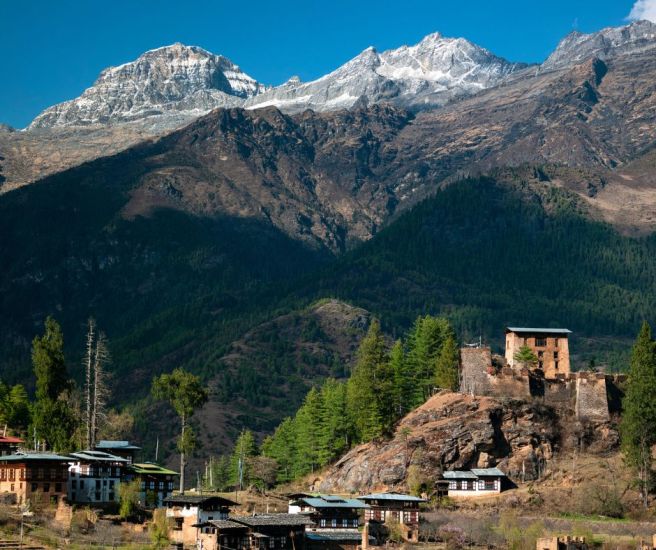Bhutan Snowman Trek
28 Days / Bhutan
Personalized Travel Advice

Dev Raj Nepal
+977 9851096523
Detailed Itinerary
01
DAY
01
Welcome to Bhutan! Upon your arrival at Paro International Airport, you’ll be warmly greeted and after completing immigration formalities, you will drive to your hotel and settle in.
Your first experience in Bhutan begins with a visit to Rinpung Dzong. Built in 1644 by Shabdrung Ngawang Namgyal, this magnificent fortress-monastery stands as a symbol of Bhutan’s rich cultural and spiritual heritage. The intricate architecture, including the five-story tower made entirely without nails, is a visual masterpiece. From the Dzong, enjoy the stunning views of the surrounding valley and mountains.
Rest in your hotel in Paro for the night.
Arrival in Paro
Welcome to Bhutan! Upon your arrival at Paro International Airport, you’ll be warmly greeted and after completing immigration formalities, you will drive to your hotel and settle in.
Your first experience in Bhutan begins with a visit to Rinpung Dzong. Built in 1644 by Shabdrung Ngawang Namgyal, this magnificent fortress-monastery stands as a symbol of Bhutan’s rich cultural and spiritual heritage. The intricate architecture, including the five-story tower made entirely without nails, is a visual masterpiece. From the Dzong, enjoy the stunning views of the surrounding valley and mountains.
Rest in your hotel in Paro for the night.
02
DAY
02
After breakfast, embark on an unforgettable hike to Taktsang Monastery (3,120 meters), also known as Tiger’s Nest, one of Bhutan’s most iconic sites. Perched 900 meters above the valley floor on a cliffside, the monastery is a revered pilgrimage site for Buddhists. According to legend, Guru Rinpoche flew to the site on the back of a tigress and meditated here in the 8th century, transforming the cave into a spiritual sanctuary. The trek offers panoramic views of the surrounding forests and valleys, making it a challenging yet rewarding experience.
In the afternoon, visit the National Museum of Bhutan, which houses a diverse collection of Bhutanese artifacts, including ancient masks, paintings, weapons, and textiles. The museum, housed in the former watchtower of Paro Dzong, offers fascinating insights into Bhutan’s history, culture, and religious practices. Overnight stay in Paro.
Paro – Hike to Taktsang Monastery
After breakfast, embark on an unforgettable hike to Taktsang Monastery (3,120 meters), also known as Tiger’s Nest, one of Bhutan’s most iconic sites. Perched 900 meters above the valley floor on a cliffside, the monastery is a revered pilgrimage site for Buddhists. According to legend, Guru Rinpoche flew to the site on the back of a tigress and meditated here in the 8th century, transforming the cave into a spiritual sanctuary. The trek offers panoramic views of the surrounding forests and valleys, making it a challenging yet rewarding experience.
In the afternoon, visit the National Museum of Bhutan, which houses a diverse collection of Bhutanese artifacts, including ancient masks, paintings, weapons, and textiles. The museum, housed in the former watchtower of Paro Dzong, offers fascinating insights into Bhutan’s history, culture, and religious practices. Overnight stay in Paro.
03
DAY
03
Your adventure begins with a drive from Paro to Drukgyel Dzong (2,580 meters), a historical site that once served as the defensive fortress against invasions from Tibet. From here, start your trek to Shana Zampa (2,870 meters), a campsite set in a picturesque valley. The trek follows the Pa Chhu River, winding through lush rice and millet fields before ascending into the forested hills. Along the way, you’ll pass small villages where locals cultivate crops and raise livestock. Overnight camp at Shana Zampa.
Paro to Shana Zampa
Your adventure begins with a drive from Paro to Drukgyel Dzong (2,580 meters), a historical site that once served as the defensive fortress against invasions from Tibet. From here, start your trek to Shana Zampa (2,870 meters), a campsite set in a picturesque valley. The trek follows the Pa Chhu River, winding through lush rice and millet fields before ascending into the forested hills. Along the way, you’ll pass small villages where locals cultivate crops and raise livestock. Overnight camp at Shana Zampa.
04
DAY
04
Today’s trek takes you to Soi Thangkha, passing through varied terrain along the Pa Chu River. As you ascend, the landscape gradually changes, offering beautiful views of the mountains ahead. The trail narrows as you move higher, passing through dense forests and small bridges that cross the stream. Upon reaching Soi Thangkha, you’ll camp in a tranquil setting, with the sounds of nature surrounding you. Overnight camp at Soi Thangkha.
Shana Zampa to Soi Thangkha
Today’s trek takes you to Soi Thangkha, passing through varied terrain along the Pa Chu River. As you ascend, the landscape gradually changes, offering beautiful views of the mountains ahead. The trail narrows as you move higher, passing through dense forests and small bridges that cross the stream. Upon reaching Soi Thangkha, you’ll camp in a tranquil setting, with the sounds of nature surrounding you. Overnight camp at Soi Thangkha.
05
DAY
05
Today’s trek leads you to Jangothang Base Camp. The journey takes you through alpine terrain, where you’ll pass by yak herders’ camps and traditional stone huts. The magnificent views of Mount Jomolhari (7,314 meters) and Jichu Drake (6,494 meters) become more prominent as you approach the camp. Jangothang Base Camp offers an exceptional vantage point for the surrounding peaks, and you’ll be able to appreciate the majestic Himalayas up close. Overnight camp at Jangothang Base Camp.
Soi Thangkha to Jangothang Base Camp
Today’s trek leads you to Jangothang Base Camp. The journey takes you through alpine terrain, where you’ll pass by yak herders’ camps and traditional stone huts. The magnificent views of Mount Jomolhari (7,314 meters) and Jichu Drake (6,494 meters) become more prominent as you approach the camp. Jangothang Base Camp offers an exceptional vantage point for the surrounding peaks, and you’ll be able to appreciate the majestic Himalayas up close. Overnight camp at Jangothang Base Camp.
06
DAY
06
Spend a full day at Jangothang Base Camp (4,080 meters) to acclimatize and explore the area. For those feeling energetic, take a hike to Tshophu Lakes, a pair of serene high-altitude lakes surrounded by meadows and blue poppies, Bhutan’s national flower. The views of Mount Jomolhari and Jichu Drake from the lakes are nothing short of breath-taking. Take this opportunity to relax and soak in the stunning scenery before continuing your trek. Overnight stay at Jangothang Base Camp.
Acclimatization Day at Jangothang
Spend a full day at Jangothang Base Camp (4,080 meters) to acclimatize and explore the area. For those feeling energetic, take a hike to Tshophu Lakes, a pair of serene high-altitude lakes surrounded by meadows and blue poppies, Bhutan’s national flower. The views of Mount Jomolhari and Jichu Drake from the lakes are nothing short of breath-taking. Take this opportunity to relax and soak in the stunning scenery before continuing your trek. Overnight stay at Jangothang Base Camp.
07
DAY
07
The trek today takes you to Lingshi, passing through dramatic landscapes and remote villages. Begin by crossing the Neyle La Pass (4,700 meters), the highest point of the day, where you’ll be rewarded with panoramic views of the Mount Jomolhari and the surrounding peaks. After descending, you’ll continue along the trail that winds down to the peaceful settlement of Lingshi, with its traditional wooden homes and yak herders. Overnight camp at Lingshi.
Jangothang to Lingshi
The trek today takes you to Lingshi, passing through dramatic landscapes and remote villages. Begin by crossing the Neyle La Pass (4,700 meters), the highest point of the day, where you’ll be rewarded with panoramic views of the Mount Jomolhari and the surrounding peaks. After descending, you’ll continue along the trail that winds down to the peaceful settlement of Lingshi, with its traditional wooden homes and yak herders. Overnight camp at Lingshi.
08
DAY
08
From Lingshi, trek to Chebisa, a remote village surrounded by high ridges and green valleys. The trek today involves steady climbs, passing through scattered settlements, forested hills, and yak pastures. Upon reaching Chebisa, you’ll find yourself camping in a serene environment, with the towering Mount Gangchen Ta (6,340 meters) looming in the distance. Overnight camp at Chebisa.
Lingshi to Chebisa
From Lingshi, trek to Chebisa, a remote village surrounded by high ridges and green valleys. The trek today involves steady climbs, passing through scattered settlements, forested hills, and yak pastures. Upon reaching Chebisa, you’ll find yourself camping in a serene environment, with the towering Mount Gangchen Ta (6,340 meters) looming in the distance. Overnight camp at Chebisa.
09
DAY
09
The path from Chebisa to Shoumothang (4,150 meters) ascends to the Gogu La Pass (4,700 meters), offering spectacular views of the snow-covered mountains. After the descent into the valley, the terrain changes, and you’ll find yourself trekking through dense forests and meadows filled with wildflowers. The campsite at Shoumothang offers a tranquil setting, surrounded by nature’s beauty. Overnight camp at Shoumothang.
Chebisa to Shoumothang
The path from Chebisa to Shoumothang (4,150 meters) ascends to the Gogu La Pass (4,700 meters), offering spectacular views of the snow-covered mountains. After the descent into the valley, the terrain changes, and you’ll find yourself trekking through dense forests and meadows filled with wildflowers. The campsite at Shoumothang offers a tranquil setting, surrounded by nature’s beauty. Overnight camp at Shoumothang.
10
DAY
10
The trek from Shoumothang to Robluthang is challenging but rewarding. You’ll climb to the Jari La Pass (4,750 meters), where the stunning views of the surrounding peaks will leave you awe-struck. After descending into the valley, the landscape opens up as you make your way to Robluthang, where you will camp for the night. Overnight camp at Robluthang.
Shoumothang to Robluthang
The trek from Shoumothang to Robluthang is challenging but rewarding. You’ll climb to the Jari La Pass (4,750 meters), where the stunning views of the surrounding peaks will leave you awe-struck. After descending into the valley, the landscape opens up as you make your way to Robluthang, where you will camp for the night. Overnight camp at Robluthang.
11
DAY
11
Trek through the scenic Shingchen La Pass (5,005 meters), the highest point of the day. The path offers dramatic vistas of the Himalayas, with towering peaks and deep valleys. After a descent, you’ll arrive at Lingmithang (4,100 meters), where you’ll camp in the peaceful surroundings of the valley. Overnight camp at Lingmithang.
Robluthang to Lingmithang
Trek through the scenic Shingchen La Pass (5,005 meters), the highest point of the day. The path offers dramatic vistas of the Himalayas, with towering peaks and deep valleys. After a descent, you’ll arrive at Lingmithang (4,100 meters), where you’ll camp in the peaceful surroundings of the valley. Overnight camp at Lingmithang.
12
DAY
12
Today’s trek leads you to the village of Laya, one of Bhutan’s most remote settlements. The path follows the valley floor, passing through forests and fields, before reaching the village nestled beneath Gangchenta (6,600 meters), also known as Tiger Mountain. Laya offers spectacular views of the surrounding peaks, making it a picturesque and memorable destination. Overnight camp at Laya.
Lingmithang to Laya
Today’s trek leads you to the village of Laya, one of Bhutan’s most remote settlements. The path follows the valley floor, passing through forests and fields, before reaching the village nestled beneath Gangchenta (6,600 meters), also known as Tiger Mountain. Laya offers spectacular views of the surrounding peaks, making it a picturesque and memorable destination. Overnight camp at Laya.
13
DAY
13
Take a well-deserved rest day at Laya, a remote village nestled in the northern part of Bhutan. This picturesque village is home to the Layaps, an ethnic group known for their distinct clothing and culture. On this day, enjoy the peaceful surroundings, explore the village, and immerse yourself in the local way of life. You can also take short walks in the vicinity, offering stunning views of snow-capped peaks and lush valleys. Overnight stay at Laya.
Rest Day at Laya
Take a well-deserved rest day at Laya, a remote village nestled in the northern part of Bhutan. This picturesque village is home to the Layaps, an ethnic group known for their distinct clothing and culture. On this day, enjoy the peaceful surroundings, explore the village, and immerse yourself in the local way of life. You can also take short walks in the vicinity, offering stunning views of snow-capped peaks and lush valleys. Overnight stay at Laya.
14
DAY
14
Today, begin your trek from Laya to Rodophu, a high-altitude campsite offering spectacular views of the Himalayan range. The trail takes you through dense alpine forests, with a steady ascent through rhododendron and juniper trees. Along the way, enjoy the serenity of nature and catch glimpses of the majestic mountains surrounding you. As you reach Rodophu, the beauty of the area, with its crystal-clear streams and expansive meadows, will leave you in awe. Overnight camping at Rodophu.
Laya to Rodophu
Today, begin your trek from Laya to Rodophu, a high-altitude campsite offering spectacular views of the Himalayan range. The trail takes you through dense alpine forests, with a steady ascent through rhododendron and juniper trees. Along the way, enjoy the serenity of nature and catch glimpses of the majestic mountains surrounding you. As you reach Rodophu, the beauty of the area, with its crystal-clear streams and expansive meadows, will leave you in awe. Overnight camping at Rodophu.
15
DAY
15
The trek from Rodophu to Narithang takes you higher into the mountains, as you continue your journey through Bhutan’s rugged terrain. The path leads you across steep, rocky slopes and alpine meadows, offering panoramic vistas of the majestic peaks, lush valleys, and winding rivers below. As you ascend gradually through an enchanting landscape of dwarf rhododendrons, you reach a small valley dotted with alpine pastures. Continuing onward, you will ascend to the Tsemo La pass (4905m), where the views of the surrounding mountains are breathtaking. After crossing the pass, the descent brings you to a series of slopes, where you are rewarded with a striking sight—a line of towering snowy peaks, with the formidable Gangla Karchung (6395m) standing proudly as the highest.
Narithang is a tranquil haven, ideal for both resting and acclimatizing to the altitude. The peaceful atmosphere allows you to unwind, reconnect with nature, and prepare for the days ahead. As the sun sets, enjoy the soothing sounds of the wilderness, reflecting on the journey so far. You’ll spend the night camping in this serene spot, surrounded by the untamed beauty of the mountains.
Rodophu to Narithang
The trek from Rodophu to Narithang takes you higher into the mountains, as you continue your journey through Bhutan’s rugged terrain. The path leads you across steep, rocky slopes and alpine meadows, offering panoramic vistas of the majestic peaks, lush valleys, and winding rivers below. As you ascend gradually through an enchanting landscape of dwarf rhododendrons, you reach a small valley dotted with alpine pastures. Continuing onward, you will ascend to the Tsemo La pass (4905m), where the views of the surrounding mountains are breathtaking. After crossing the pass, the descent brings you to a series of slopes, where you are rewarded with a striking sight—a line of towering snowy peaks, with the formidable Gangla Karchung (6395m) standing proudly as the highest.
Narithang is a tranquil haven, ideal for both resting and acclimatizing to the altitude. The peaceful atmosphere allows you to unwind, reconnect with nature, and prepare for the days ahead. As the sun sets, enjoy the soothing sounds of the wilderness, reflecting on the journey so far. You’ll spend the night camping in this serene spot, surrounded by the untamed beauty of the mountains.
16
DAY
16
From Narithang, continue your trek to Tarina, passing through lush forests and alpine meadows. As you descend slightly to Tarina, you’ll find yourself surrounded by beautiful valleys and distant peaks. The landscape shifts, offering a different perspective of the mountains. The peaceful village of Tarina is a tranquil haven to rest, offering stunning views of the surrounding landscape. Overnight camping at Tarina.
Narithang to Tarina
From Narithang, continue your trek to Tarina, passing through lush forests and alpine meadows. As you descend slightly to Tarina, you’ll find yourself surrounded by beautiful valleys and distant peaks. The landscape shifts, offering a different perspective of the mountains. The peaceful village of Tarina is a tranquil haven to rest, offering stunning views of the surrounding landscape. Overnight camping at Tarina.
17
DAY
17
Today’s trek from Tarina to Woche is a continuation of your high-altitude journey, with a trail that passes through forests of juniper, fir, and rhododendron. The route gradually descends to the village of Woche, offering you a chance to experience the beautiful natural surroundings and the remote village life. Woche is a great spot to immerse yourself in the peace and serenity of the Bhutanese wilderness. Overnight camping at Woche.
Tarina to Woche
Today’s trek from Tarina to Woche is a continuation of your high-altitude journey, with a trail that passes through forests of juniper, fir, and rhododendron. The route gradually descends to the village of Woche, offering you a chance to experience the beautiful natural surroundings and the remote village life. Woche is a great spot to immerse yourself in the peace and serenity of the Bhutanese wilderness. Overnight camping at Woche.
18
DAY
18
Begin your climb through the Woche Valley, crossing a small stream before navigating a moraine. Afterward, descend to a wooden bridge that spans the Woche Chu River, then ascend past a crystal-clear glacial lake to reach the Keche La pass (4650m). From here, you’ll be treated to stunning panoramic views of the surrounding mountains, including the striking three-pronged peaks of Jejegangphu Gang.
The trail then descends into the Pochu Valley, leading you to Thaga village (4050m). Be prepared for harsh, cold winds in the late afternoon, especially during autumn. From Thaga, you will continue descending, passing through scattered settlements and beautiful waterfalls as you follow the Phochu River bed, eventually arriving at Lhedi (4200m). Lhedi is a small but functional village with a school, a Basic Health Unit, and a wireless station, providing a welcome stop as you continue your trek through this remote and rugged landscape.
Woche to Lhedi
Begin your climb through the Woche Valley, crossing a small stream before navigating a moraine. Afterward, descend to a wooden bridge that spans the Woche Chu River, then ascend past a crystal-clear glacial lake to reach the Keche La pass (4650m). From here, you’ll be treated to stunning panoramic views of the surrounding mountains, including the striking three-pronged peaks of Jejegangphu Gang.
The trail then descends into the Pochu Valley, leading you to Thaga village (4050m). Be prepared for harsh, cold winds in the late afternoon, especially during autumn. From Thaga, you will continue descending, passing through scattered settlements and beautiful waterfalls as you follow the Phochu River bed, eventually arriving at Lhedi (4200m). Lhedi is a small but functional village with a school, a Basic Health Unit, and a wireless station, providing a welcome stop as you continue your trek through this remote and rugged landscape.
19
DAY
19
From Lhedi, continue the trek to Thanza, the final destination in this segment of your journey. The path to Thanza takes you through forests, past rivers, and along ridgelines, offering stunning vistas of snow-covered peaks. Today’s trek is relatively easier. We’ll follow the north bank of the Phochu River, passing by several small farms, eventually reaching Chuzo Village (4090m) around lunchtime. Along the way, we will visit the historic Chezo Dzong. Continuing along the riverbed, the trail then takes us up a steep hill, offering a commanding view of Thanza Valley at 4250m.
Lhedi to Thanza (4,250 meters)
From Lhedi, continue the trek to Thanza, the final destination in this segment of your journey. The path to Thanza takes you through forests, past rivers, and along ridgelines, offering stunning vistas of snow-covered peaks. Today’s trek is relatively easier. We’ll follow the north bank of the Phochu River, passing by several small farms, eventually reaching Chuzo Village (4090m) around lunchtime. Along the way, we will visit the historic Chezo Dzong. Continuing along the riverbed, the trail then takes us up a steep hill, offering a commanding view of Thanza Valley at 4250m.
20
DAY
20
Today, you can either visit Thanza Village or explore nearby glacial lakes. Thanza is a pristine, medieval-like village where residents craft their own clothing, weaving and dyeing materials by hand, and creating distinctive hats, boots, and jewelry. Their stone-built homes feature hand-hewn wood shingles and clay mortar. The locals survive on a diet of grains, yak meat, and cheese from the lower valleys. Alternatively, hike through small moraine rocks to reach the Raphstreng Tsho and Thorthormi Tsho lakes, the sources of the Phochu River. The view of Table Mountain (Zongphu Gang), towering at 7100m, offers a dramatic backdrop of a 3000m-high ice and snow wall behind Thanza Village.
Rest day at Thanza
Today, you can either visit Thanza Village or explore nearby glacial lakes. Thanza is a pristine, medieval-like village where residents craft their own clothing, weaving and dyeing materials by hand, and creating distinctive hats, boots, and jewelry. Their stone-built homes feature hand-hewn wood shingles and clay mortar. The locals survive on a diet of grains, yak meat, and cheese from the lower valleys. Alternatively, hike through small moraine rocks to reach the Raphstreng Tsho and Thorthormi Tsho lakes, the sources of the Phochu River. The view of Table Mountain (Zongphu Gang), towering at 7100m, offers a dramatic backdrop of a 3000m-high ice and snow wall behind Thanza Village.
21
DAY
21
On the final day of this segment, trek from Thanza to Tshochena, a breathtaking campsite in the high Himalayas. This stretch will take you into the heart of Bhutan’s pristine wilderness, with spectacular views of the snow-capped peaks, glaciers, and alpine lakes. Tshochena is a place of profound tranquility and offers the chance to reflect on the journey thus far as you experience the rugged beauty of the region. Overnight camping at Tshochena.
Thanza to Tshochena
On the final day of this segment, trek from Thanza to Tshochena, a breathtaking campsite in the high Himalayas. This stretch will take you into the heart of Bhutan’s pristine wilderness, with spectacular views of the snow-capped peaks, glaciers, and alpine lakes. Tshochena is a place of profound tranquility and offers the chance to reflect on the journey thus far as you experience the rugged beauty of the region. Overnight camping at Tshochena.
22
DAY
22
Today’s journey takes you through a stunning landscape of snow-capped peaks as the trail gently ascends and undulates. We cross the Loju La (5100m), where the path winds around ridges, revealing expansive and breathtaking views. Many of these peaks remain unclimbed, enhancing the sense of exclusivity in the panorama that unfolds before us. Our campsite is nestled in a peaceful patch of grassy tundra, tucked between barren rocks and the sound of trickling streams, offering a serene spot to rest and absorb the beauty of the surroundings.
Tshochena to Jichu Dramo
Today’s journey takes you through a stunning landscape of snow-capped peaks as the trail gently ascends and undulates. We cross the Loju La (5100m), where the path winds around ridges, revealing expansive and breathtaking views. Many of these peaks remain unclimbed, enhancing the sense of exclusivity in the panorama that unfolds before us. Our campsite is nestled in a peaceful patch of grassy tundra, tucked between barren rocks and the sound of trickling streams, offering a serene spot to rest and absorb the beauty of the surroundings.
23
DAY
23
Today’s trek takes us through a moraine path as we ascend to the scenic Rinchen Zoe Pass (5350m), which marks the boundary between the Phochu and Mangdechu basins. From this pass, we are treated to views of Gangkar Puensum (7520m), the highest peak in Bhutan. The contrast between the lush forests below and the barren high-altitude terrain above is striking. As we descend through a broad, marshy valley dotted with lakes, yak pastures, and steep moraine slopes, we make our way to Tampe Chu, surrounded by rhododendron and juniper forests. We camp at Thongsa Thang (4400m), a short distance from Chukarpo, offering a peaceful retreat in the heart of nature.
Jichu Dramo to Chukarpo
Today’s trek takes us through a moraine path as we ascend to the scenic Rinchen Zoe Pass (5350m), which marks the boundary between the Phochu and Mangdechu basins. From this pass, we are treated to views of Gangkar Puensum (7520m), the highest peak in Bhutan. The contrast between the lush forests below and the barren high-altitude terrain above is striking. As we descend through a broad, marshy valley dotted with lakes, yak pastures, and steep moraine slopes, we make our way to Tampe Chu, surrounded by rhododendron and juniper forests. We camp at Thongsa Thang (4400m), a short distance from Chukarpo, offering a peaceful retreat in the heart of nature.
24
DAY
24
After crossing the river, we follow the main valley into the forest, where the temperatures warm slightly. The surroundings are picturesque, with the valley’s beauty complemented by distant snow-capped peaks. The trail meanders through boulders along the riverbank before entering a dense forest of pines, rhododendrons, birch, and maple. The ground beneath our feet is soft, with mosses and mud reflecting the damp, lush conditions. After a solid day’s trek, we arrive at our camp just below our final pass. From here, we ascend through the forest along a narrow valley to a hanging lake, or tarn. This climb is sustained and steep, as we gain significant altitude, but the reward is well worth the effort: a stunning campsite by the end of the Tampe Tsho lake at 4320m, offering a serene setting for our last mountain camp.
Chukarpo to Tampe Tsho
After crossing the river, we follow the main valley into the forest, where the temperatures warm slightly. The surroundings are picturesque, with the valley’s beauty complemented by distant snow-capped peaks. The trail meanders through boulders along the riverbank before entering a dense forest of pines, rhododendrons, birch, and maple. The ground beneath our feet is soft, with mosses and mud reflecting the damp, lush conditions. After a solid day’s trek, we arrive at our camp just below our final pass. From here, we ascend through the forest along a narrow valley to a hanging lake, or tarn. This climb is sustained and steep, as we gain significant altitude, but the reward is well worth the effort: a stunning campsite by the end of the Tampe Tsho lake at 4320m, offering a serene setting for our last mountain camp.
25
DAY
25
Today’s trek starts with a steep climb to the Tampela Pass (4600m). From the pass, we descend toward the beautiful Omtsho Lake, where the famous 15th-century saint, Terton Pema Lingpa, is said to have miraculously discovered a treasure. The trail leads us to the lake’s shore, passing its outlet marked by prayer flags, before descending steeply past a waterfall to a smaller lake. Continuing down, we reach the left bank of the Nika Chu River, where the terrain flattens as we walk through a mix of forests. Soon, we come to a large open area near the confluence of a major eastern tributary. After crossing a wooden bridge, the path takes us along mixed forests and yak pastures before arriving at Maraothang (3620m), a wide, open area where we’ll set up our final camp. Here, we’ll encounter the first shop since Laya—a quaint wooden house by the river.
Tampe Tsho – Maraothang
Today’s trek starts with a steep climb to the Tampela Pass (4600m). From the pass, we descend toward the beautiful Omtsho Lake, where the famous 15th-century saint, Terton Pema Lingpa, is said to have miraculously discovered a treasure. The trail leads us to the lake’s shore, passing its outlet marked by prayer flags, before descending steeply past a waterfall to a smaller lake. Continuing down, we reach the left bank of the Nika Chu River, where the terrain flattens as we walk through a mix of forests. Soon, we come to a large open area near the confluence of a major eastern tributary. After crossing a wooden bridge, the path takes us along mixed forests and yak pastures before arriving at Maraothang (3620m), a wide, open area where we’ll set up our final camp. Here, we’ll encounter the first shop since Laya—a quaint wooden house by the river.
26
DAY
26
Our final day of trekking begins with a gentle descent as we follow the Nika Chu River through scenic forests. The trail gradually eases into a broader, well-trodden path, passing through beautiful valleys and small settlements. We’ll reach the village of Sephu, where the road meets the larger route leading to Punakha, marking the end of our epic trek. From here, we board our vehicle for the drive to Punakha, one of Bhutan’s most picturesque towns.
As we make our way down the valley, the views of terraced fields and the snow-capped peaks of the Himalayas behind us offer a stunning backdrop. Upon arrival in Punakha, we are greeted by the Punakha Dzong, a spectacular fortress situated at the confluence of the Pho and Mo Chhu rivers. The town’s lush greenery and the serene atmosphere make it an ideal place to reflect on the journey we’ve just completed. The day ends with a sense of accomplishment and relaxation as we settle into our hotel, ready to explore this enchanting valley or simply unwind after our incredible trek.
Maraothang to Sephu to Punakha
Our final day of trekking begins with a gentle descent as we follow the Nika Chu River through scenic forests. The trail gradually eases into a broader, well-trodden path, passing through beautiful valleys and small settlements. We’ll reach the village of Sephu, where the road meets the larger route leading to Punakha, marking the end of our epic trek. From here, we board our vehicle for the drive to Punakha, one of Bhutan’s most picturesque towns.
As we make our way down the valley, the views of terraced fields and the snow-capped peaks of the Himalayas behind us offer a stunning backdrop. Upon arrival in Punakha, we are greeted by the Punakha Dzong, a spectacular fortress situated at the confluence of the Pho and Mo Chhu rivers. The town’s lush greenery and the serene atmosphere make it an ideal place to reflect on the journey we’ve just completed. The day ends with a sense of accomplishment and relaxation as we settle into our hotel, ready to explore this enchanting valley or simply unwind after our incredible trek.
26
DAY
26
In the morning, we begin with a visit to the majestic Punakha Dzong, one of Bhutan’s most impressive architectural marvels. Located at the confluence of the Pho Chhu and Mo Chhu rivers, this fortress-monastery is a stunning example of traditional Bhutanese design, with intricate woodwork and beautiful courtyards. You’ll have the chance to explore the grand halls and temples within, which hold significant religious and historical importance.
Afterward, we continue our journey to Paro. Upon arrival, we head to Kyichu Lhakhang, one of Bhutan’s oldest and most sacred temples, built in the 7th century by the Tibetan King Songtsen Gampo. The peaceful atmosphere and stunning architecture make it a perfect spot for reflection and understanding Bhutan’s deep spiritual heritage.
In the evening, we return to our hotel in Paro for some well-deserved relaxation, soaking in the serene surroundings of the valley before the final leg of our Bhutan adventure.
Punakha to Paro
In the morning, we begin with a visit to the majestic Punakha Dzong, one of Bhutan’s most impressive architectural marvels. Located at the confluence of the Pho Chhu and Mo Chhu rivers, this fortress-monastery is a stunning example of traditional Bhutanese design, with intricate woodwork and beautiful courtyards. You’ll have the chance to explore the grand halls and temples within, which hold significant religious and historical importance.
Afterward, we continue our journey to Paro. Upon arrival, we head to Kyichu Lhakhang, one of Bhutan’s oldest and most sacred temples, built in the 7th century by the Tibetan King Songtsen Gampo. The peaceful atmosphere and stunning architecture make it a perfect spot for reflection and understanding Bhutan’s deep spiritual heritage.
In the evening, we return to our hotel in Paro for some well-deserved relaxation, soaking in the serene surroundings of the valley before the final leg of our Bhutan adventure.
28
DAY
28
Your journey in Bhutan concludes today with a transfer to Paro International Airport for your flight back home or onward to your next destination. Reflect on the breathtaking landscapes, spiritual encounters, and the warm hospitality that you’ve experienced during this unforgettable journey through Bhutan
Paro-Departure
Your journey in Bhutan concludes today with a transfer to Paro International Airport for your flight back home or onward to your next destination. Reflect on the breathtaking landscapes, spiritual encounters, and the warm hospitality that you’ve experienced during this unforgettable journey through Bhutan
Includes / Excludes
Inclusions
-
Hotel Accommodations on a twin/double sharing basis
-
Dinning tents, kitchen tent & toilet tent
-
Sleeping tents, sleeping mats & pillows
-
Tables, chairs, hot water bags
-
Cook & assistants during the trek
-
Horses to carry trek equipment
-
All Meals in Bhutan
-
Transport by private vehicle
-
Government approved 3-star hotels
-
English speaking guide
-
Permits, entrance fees, & sightseeing
Exclusions
-
International Airfare
-
Travel Insurance
-
Bhutan Visa Fee
-
Personal Expenses: Drinks, Phone bill, Tips etc
-
Sleeping Bag
Trip Info
The best time to do the Snowman Trek is during autumn (mid-September to November) and spring (March to early May).
Autumn (September to November): This is the most popular season for trekking in Bhutan. The weather is generally stable, with clear skies and crisp air. The landscapes are lush, and the views of the Himalayan peaks, including Mt. Jomolhari, are spectacular. The autumn months also offer a chance to witness the vibrant colors of fall foliage.
Spring (March to early May): Spring brings warmer temperatures and blooming rhododendrons, adding a burst of color to the landscapes. The days are mild, and the skies remain clear, providing great visibility of the mountains.
For this tour, we prioritize both comfort and safety by providing well-maintained vehicles suited to the group size. If the group consists of fewer than 8 participants, we will use a high-roof Toyota HiAce, a spacious and reliable vehicle with ample legroom and luggage space. For groups larger than 8, we will upgrade to a Mini-bus, ensuring everyone has a comfortable and enjoyable journey together.
Our drivers are highly experienced professionals with extensive knowledge of the routes, terrain, and road conditions. They are trained in defensive driving and safety protocols, ensuring a smooth and secure travel experience. With years of experience navigating mountain roads and varying weather conditions, they prioritize passenger safety while maintaining a steady and comfortable ride.
Additionally, our vehicles undergo regular maintenance and safety checks to ensure reliability throughout the journey. Whether winding through mountain passes or traveling along scenic valleys, you can rest assured that your transportation is in capable hands, allowing you to fully enjoy the beauty of the destination without any worries.
Most parts of this trek will take you to the remote regions of Bhutan. Therefore, there is a scarcity of luxurious accommodations. At regional centers and big towns like Paro and Thimphu, we provide high grade hotels that provide comfort and warmth.
During the Trek
However, during the trek, the accommodations are primarily in tents, where trekkers camp in designated spots at various points along the trail. These campsites are typically set up in meadows or near small villages, offering trekkers a chance to experience the beauty of the highlands up close. The camps are equipped with basic facilities like sleeping tents and shared dining tents, where meals are served. In some places, trekkers can stay in simple guesthouses or hotels that provide comfort before and after the trek. The accommodations are functional and designed to complement the trekking experience, offering a cozy respite after a long day on the trail.
Food on this typical Bhutan trek is mostly simple but nutritious, designed to provide energy for the long days of trekking. In the villages and towns, meals are typically served at local guesthouses, where you’ll find traditional Bhutanese dishes such as ema datshi (a spicy cheese and chili dish) and phaksha paa (pork with radishes). During the trek, meals are often prepared by the trek crew, including porters and cooks, and served at the campsites. Expect to have a variety of hearty, locally sourced food, such as rice, vegetables, lentils, and noodles. Breakfast may include porridge, eggs, and bread, while dinners often consist of stews and curries. Given the high-altitude conditions, hydration is crucial, and water is regularly provided during the trek, though it’s recommended to drink purified water.
Clothing
- Light layers: T-shirts, long-sleeve shirts, and a couple of warm sweaters or fleeces.
- Thermal wear: Necessary for high-altitude areas and trekking days (especially for evenings).
- Outerwear: Warm, windproof jacket; waterproof jacket or poncho (for unexpected rain).
- Pants: Comfortable trekking pants and a few pairs of casual pants for cultural sites and town visits.
- Comfortable shoes: Hiking boots for trekking and sturdy, comfortable walking shoes for towns.
- Warm socks: Especially for trekking days at higher altitudes.
Accessories
- Hat, gloves, and scarf
- Sun hat and sunglasses
- Light daypack
- Trekking poles
- Quick-dry towel
Personal Items
- Toiletries: Soap, shampoo, toothbrush, toothpaste, and other personal hygiene items.
- Sunscreen and lip balm: High SPF for sun protection at high altitudes.
- Moisturizer: Dry weather may affect the skin.
- Hand sanitizer and wet wipes: For cleanliness on the go.
- First aid kit: Basic items like band-aids, pain relievers, blister treatment, altitude sickness medication (consult a doctor before traveling).
- Insect repellent: For rural areas.
Trekking Essentials
- Reusable water bottle
- Water purification tablets
- Energy snacks
- Headlamp or flashlight
Cultural Considerations
- Modest clothing: Long pants and long-sleeved shirts are preferred for monastery visits.
- Shawl or scarf: Useful when entering temples or Dzongs.
- Reusable bags: For storing and organizing belongings.
Acclimatization is a critical part of the Snowman Trek due to the high altitudes and challenging terrain. As you trek through remote regions of Bhutan, you’ll be ascending to heights above 4,500 meters, with the highest passes reaching over 5,000 meters. The lack of oxygen at these altitudes can lead to altitude sickness, making it essential to give your body time to adjust. To counter this, the trek is designed with built-in acclimatization days, where you rest at key points, allowing your body to adapt to the changing altitude gradually.
Strenuous walking, particularly over rugged trails, high mountain passes, and through remote villages, adds another level of difficulty. The terrain can be steep, uneven, and at times, slippery. To manage this, it’s important to pace yourself and stay hydrated, taking regular breaks to rest and adjust. Maintaining a slow, steady pace helps prevent exhaustion and reduces the risk of altitude sickness. The trek also involves camping in remote areas, where cold temperatures at night can add another layer of challenge. Dressing in layers, keeping warm, and ensuring you have proper trekking gear for both the cold and the physical strain are key. Being mentally prepared for the strenuous nature of the trek, listening to your body, and not rushing will make the journey more enjoyable and safer.
Scenic Landscapes and High Altitude Passes
The Snowman Trek takes you through some of Bhutan’s most remote and pristine regions, where you’ll be rewarded with breathtaking views of snow-capped peaks, lush valleys, and alpine meadows. Expect to traverse high-altitude passes above 4,500 meters, each providing a unique perspective of Bhutan’s rugged beauty. Glacial lakes and tranquil valleys add to the trek’s appeal, offering moments of serenity amidst the challenge.
Camping and Remote Villages
Camping is a significant part of the Snowman Trek. Each night, you’ll camp in peaceful, remote areas—often near glacial lakes or at the base of towering peaks—giving you the chance to immerse yourself in nature. Expect to stay in quiet, idyllic settings where you can rest, reflect, and rejuvenate for the next day’s journey. Along the route, you’ll also pass through small, traditional villages, where the locals maintain a lifestyle largely untouched by modern life.
Challenging Terrain and Strenuous Walking
The trek demands physical endurance, as the trail involves long days of walking through rugged, uneven terrain. The high-altitude passes and steep climbs require stamina and preparation, but each step is rewarded with stunning views. The challenging walk, combined with the altitude, makes it essential to be physically ready for the trek and to take time for proper acclimatization along the way.
Cultural Encounters
In addition to the natural beauty, the Snowman Trek offers a deep cultural experience. As you pass through remote villages and visit ancient monasteries, you’ll encounter Bhutanese traditions that have been preserved for centuries. The warm hospitality of the villagers adds a personal touch to the adventure, making this trek as much about cultural immersion as it is about physical challenge.
Wildlife and Flora
As you traverse the rugged terrains of the Snowman Trek, you’ll be immersed in a diverse ecosystem. The trek weaves through alpine meadows, forests, and high mountain passes, providing a stunning backdrop for the flora and fauna that thrive in these remote areas. The lower altitudes are rich in dense forests of rhododendrons, pines, and junipers, while the higher regions reveal alpine pastures adorned with wildflowers.
Wildlife sightings are rare but equally rewarding. The blue sheep, known for their elusive nature, are a common sight on the slopes, grazing near the higher altitudes. Occasionally, you may spot a Himalayan Tahr or even the rare snow leopard. Along the trek, the chirping of various bird species adds to the symphony of nature.
FAQs
Personalized Travel Advice

Dev Raj Nepal
+977 9851096523

